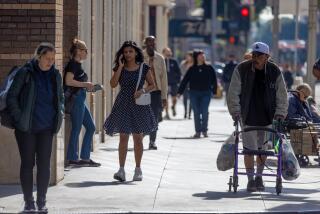With Graying of America, More of Us Are Staying Put
WASHINGTON — Americans are showing less of an inclination to move, reflecting in part the aging of the population. When people do change addresses, the South and West remain the favored locales, the Census Bureau says.
Recent estimates show that 15.9% of the population, or roughly 43 million people, moved between March 1998 and March 1999, compared with 16% in the previous one-year period, and 17.8% during the same period 10 years earlier.
The pace of relocations has not picked up since 20.2% of Americans moved between March 1984 and March 1985, up from 17.3% in the previous one-year period.
Although the economy is good, analysts attribute the current trend in large part to the aging of the U.S. population, including a generation of baby boomers hitting middle age, and an increase in homeownership.
Baby boomers typically are defined as those born between 1946 and 1964.
In July 1999 the median age of the American population was 35.5, compared with 32.8 in July 1990. The National Assn. of Realtors said the median age of home buyers jumped from 34 in 1989 to 39 in 1999.
“The older you get, the less likely you are to move,” census demographer Carol Faber said.
There were 186 million homeowners in 1999, 26 million more than in 1988, and homeowners are less likely to relocate than renters, according to the Census Bureau. During the same time span, the number of renters increased just 5 million, to 81 million. The agency did not keep track of that statistic before 1988.
When people do move, their new address is not far from the old one. Fifty-nine percent of movers between March 1998 and March 1999 relocated within the same county, and 20% went to another county in the same state.
Out-of-state movers accounted for 18%, and those people usually went to warmer locales in the South and West, reflecting decade-long shifts in the American population, Faber said.
The Northeast had the lowest moving rate among the nation’s regions (11.7%), followed by the Midwest (15.1%). The South (17.1%) and the West (18.5%) were both above the national average.
The South and West continue to attract a steady stream of people relocating because of corporate moves and retirement, said Kevin Roth, a senior economist at the National Assn. of Realtors. The average home buyer in the South moved 259 miles, Roth said, while two-thirds of home buyers in the Northeast moved 10 miles or less.
More people are still moving out of big cities than into them, but the net migration into metropolitan areas was 1.4 million people, the largest net gain since 2.4 million people moved into metro areas between 1991 and 1992.
Last year, 3.7 million people moved into cities while 6.2 million moved out. More than 6.5 million moved into suburban communities last year, while 3.9 million moved out.
The majority of the metro area growth was due to 1.3 million new residents classified by the Census Bureau as “movers from abroad.” About 40% of all people who moved into the country were non-Hispanic whites, and 32% were of Hispanic origin.
“That’s the only thing that saved the Northeast--persons from abroad,” Faber said. “That seems to be what makes the difference, because so many people from abroad settle in metro areas rather than non-metro areas.”
Other highlights from the report:
* About 1 in 3 renters, compared with fewer than 1 in 10 homeowners, moved during the one-year period.
* Moving rates declined with age: 32% of people in their 20s moved, while only 5% of those 65 and over did so.
More to Read
Get the L.A. Times Politics newsletter
Deeply reported insights into legislation, politics and policy from Sacramento, Washington and beyond. In your inbox three times per week.
You may occasionally receive promotional content from the Los Angeles Times.










